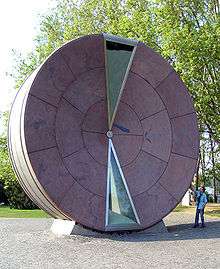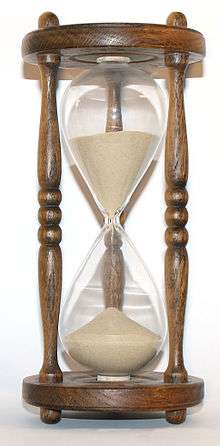Hourglass
An hourglass (or sandglass, sand timer, sand clock or egg timer) is a device used to measure the passage of time. It comprises two glass bulbs connected vertically by a narrow neck that allows a regulated flow of a substance (historically sand) from the upper bulb to the lower one. Typically the upper and lower bulbs are symmetric so that the hourglass will measure the same duration regardless of orientation. The specific duration of time a given hourglass measures is determined by factors including the quantity and coarseness of the particulate matter, the bulb size, and the neck width.
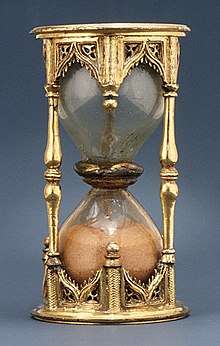
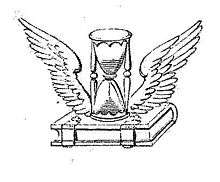
Depictions of an hourglass as a symbol of the passage of time are found in art, especially on tombstones or other monuments, from antiquity to the present day. The form of a winged hourglass has been used as a literal depiction of the well-known Latin epitaph tempus fugit ("time flies").
History
Antiquity
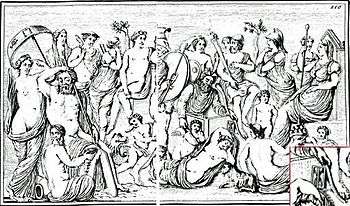
The origin of the hourglass is unclear. Its predecessor the clepsydra, or water clock, is known to have existed in Babylon and Egypt as early as the 16th century BCE.
Early Middle Age

There are no records of the hourglass existing in Europe prior to the Early Middle Ages; the first documented example dates from the 8th century CE, crafted by a Frankish monk named Liutprand who served at the cathedral in Chartres, France.[1][2][3] But it was not until the 14th century that the hourglass was seen commonly, the earliest firm evidence being a depiction in the 1338 fresco Allegory of Good Government by Ambrogio Lorenzetti.[4]
Use of the marine sandglass has been recorded since the 14th century. The written records about it were mostly from logbooks of European ships.[3] In the same period it appears in other records and lists of ships stores. The earliest recorded reference that can be said with certainty to refer to a marine sandglass dates from c. 1345, in a receipt of Thomas de Stetesham, clerk of the King's ship La George, in the reign of Edward III of England; translated from the Latin, the receipt says: in 1345:[5][6]
"The same Thomas accounts to have paid at Lescluse, in Flanders, for twelve glass horologes (" pro xii. orlogiis vitreis "), price of each 4½ gross', in sterling 9s. Item, For four horologes of the same sort (" de eadem secta "), bought there, price of each five gross', making in sterling 3s. 4d."[1][5][6]
Marine sandglasses were very popular on board ships, as they were the most dependable measurement of time while at sea. Unlike the clepsydra, the motion of the ship while sailing did not affect the hourglass. The fact that the hourglass also used granular materials instead of liquids gave it more accurate measurements, as the clepsydra was prone to get condensation inside it during temperature changes.[7] Seamen found that the hourglass was able to help them determine longitude, distance east or west from a certain point, with reasonable accuracy.[7]
The hourglass also found popularity on land. As the use of mechanical clocks to indicate the times of events like church services became more common, creating a "need to keep track of time", the demand for time-measuring devices increased. Hourglasses were essentially inexpensive, as they required no rare technology to make and their contents were not hard to come by, and as the manufacturing of these instruments became more common, their uses became more practical.[7]
Hourglasses were commonly seen in use in churches, homes, and work places to measure sermons, cooking time, and time spent on breaks from labor.[3] Because they were being used for more everyday tasks, the model of the hourglass began to shrink. The smaller models were more practical and very popular as they made timing more discreet.
After 1500, the hourglass was not as widespread as it had been. This was due to the development of the mechanical clock, which became more accurate, smaller and cheaper, and made keeping time easier. The hourglass, however, did not disappear entirely. Although they became relatively less useful as clock technology advanced, hourglasses remained desirable in their design. The oldest known surviving hourglass resides in the British Museum in London.[3]
Not until the 18th century did John Harrison come up with a marine chronometer that significantly improved on the stability of the hourglass at sea. Taking elements from the design logic behind the hourglass, he made a marine chronometer in 1761 that was able to accurately measure the journey from England to Jamaica accurate within five seconds.
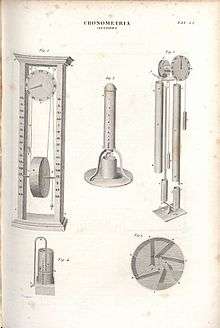
Design
Little written evidence exists to explain why its external form is the shape that it is. The glass bulbs used, however, have changed in style and design over time. While the main designs have always been ampoule in shape, the bulbs were not always connected. The first hourglasses were two separate bulbs with a cord wrapped at their union that was then coated in wax to hold the piece together and let sand flow in between.[8] It was not until 1760 that both bulbs were blown together to keep moisture out of the bulbs and regulate the pressure within the bulb that varied the flow.[7]
Material
While some early hourglasses actually did use sand as the granular mixture to measure time, many did not use sand at all. The material used in most bulbs was a combination of "powdered marble, tin/lead oxides, and pulverized, burnt eggshell".[3] Over time, different textures of granule matter were tested to see which gave the most constant flow within the bulbs. It was later discovered that for the perfect flow to be achieved the ratio of granule bead to the width of the bulb neck needed to be 1/12 or more but not greater than 1/2 the neck of the bulb.[9]
Practical uses

Hourglasses were an early dependable and accurate measure of time. The rate of flow of the sand is independent of the depth in the upper reservoir, and the instrument will not freeze in cold weather.[3] From the 15th century onwards, hourglasses were being used in a range of applications at sea, in the church, in industry, and in cookery.
During the voyage of Ferdinand Magellan around the globe, 18 hourglasses from Barcelona were in the ship's inventory, after the trip had been authorized by King Charles I of Spain.[10] It was the job of a ship's page to turn the hourglasses and thus provide the times for the ship's log. Noon was the reference time for navigation, which did not depend on the glass, as the sun would be at its zenith.[11] A number of sandglasses could be fixed in a common frame, each with a different operating time, e.g. as in a four-way Italian sandglass likely from the 17th century, in the collections of the Science Museum, in South Kensington, London, which could measure intervals of quarter, half, three-quarters, and one hour (and which were also used in churches, for priests and ministers to measure lengths of sermons).[12]
Modern practical uses
While they are no longer widely used for keeping time, some institutions do maintain them. Both houses of the Australian Parliament use three hourglasses to time certain procedures, such as divisions.[13]
The sandglass is still widely used as the kitchen egg timer; for cooking eggs, a three-minute timer is typical,[14] hence the name "egg timer" for three-minute hourglasses. Egg timers are sold widely as souvenirs. Sand timers are also sometimes used in games such as Pictionary and Boggle to implement a time constraint on rounds of play.
Symbolic uses

Unlike most other methods of measuring time, the hourglass concretely represents the present as being between the past and the future, and this has made it an enduring symbol of time itself.
The hourglass, sometimes with the addition of metaphorical wings, is often depicted as a symbol that human existence is fleeting, and that the "sands of time" will run out for every human life.[15] It was used thus on pirate flags, to strike fear into the hearts of the pirates' victims. In England, hourglasses were sometimes placed in coffins,[16] and they have graced gravestones for centuries. The hourglass was also used in alchemy as a symbol for hour.
The former Metropolitan Borough of Greenwich in London used an hourglass on its coat of arms, symbolising Greenwich's role as the origin of GMT. The district's successor, the Royal Borough of Greenwich, uses two hourglasses on its coat of arms.
Modern symbolic uses

Recognition of the hourglass as a symbol of time has survived its obsolescence as a timekeeper. For example, the American television soap opera Days of Our Lives, since its first broadcast in 1965, has displayed an hourglass in its opening credits, with the narration, "Like sands through the hourglass, so are the days of our lives," spoken by Macdonald Carey.
Various computer graphical user interfaces may change the pointer to an hourglass during a period when the program is in the middle of a task, and may not accept user input. During that period other programs, for example in different windows, may work normally. When such an hourglass does not disappear, it suggests a program is in an infinite loop and needs to be terminated, or is waiting for some external event (such as the user inserting a CD). Unicode has an HOURGLASS symbol at U+231B (⌛).
Hourglass motif
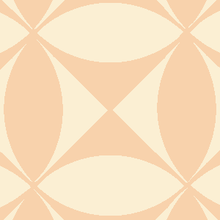
Because of its symmetry, graphic signs resembling an hourglass are seen in the art of cultures which never encountered such objects. Vertical pairs of triangles joined at the apex are common in Native American art; both in North America,[17] where it can represent, for example, the body of the Thunderbird or (in more elongated form) an enemy scalp,[18][19] and in South America, where it is believed to represent a Chuncho jungle dweller.[20] In Zulu textiles they symbolise a married man, as opposed to a pair of triangles joined at the base, which symbolise a married woman.[21] Neolithic examples can be seen among Spanish cave paintings.[22][23] Observers have even given the name "hourglass motif" to shapes which have more complex symmetry, such as a repeating circle and cross pattern from the Solomon Islands.[24] Both the members of Project Tic Toc, from television series the Time Tunnel and the Challengers of the Unknown use symbols of the hourglass representing either time travel or time running out.
- Hourglasses in art
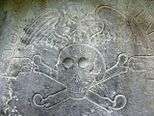 17thC tombstone in the mausoleum of John Livingstone, 'an apothecary in Edinburgh', who fell victim to the plague 1645
17thC tombstone in the mausoleum of John Livingstone, 'an apothecary in Edinburgh', who fell victim to the plague 1645- Tomb in the Sebastiansfriedhof, Salzburg
 Know thyself - Youth between Vice and Virtue (attributed to Jacob Jordaens)
Know thyself - Youth between Vice and Virtue (attributed to Jacob Jordaens)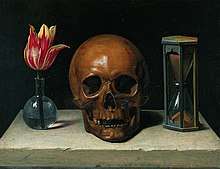 Philippe de Champaigne Still-Life with a Skull, vanitas painting, 1671
Philippe de Champaigne Still-Life with a Skull, vanitas painting, 1671_by_Johann_Zoffany.jpg) Self-portrait (with hourglass and skull) by Johann Zoffany, circa 1776
Self-portrait (with hourglass and skull) by Johann Zoffany, circa 1776
References

- F.J.Britten (190x). OLD CLOCKS AND WATCHES & THEIR MAKERS. LONDON, B. T. BATSFORD, 94 HIGH HOLBORN. pp. 16 and 249.
- Orton, Fred; Wood, Ian; Lees, Clare A. (2008-02-01). Fragments of history: rethinking the Ruthwell and Bewcastle monuments. Manchester University Press. ISBN 9780719072574.
- Mills, A.A.; Day, S.; Parkes, S. (1996). "Mechanics of the sandglass" (PDF). European Journal of Physics. 17. pp. 97–109. Bibcode:1996EJPh...17...97M. doi:10.1088/0143-0807/17/3/001.
- Frugoni, Chiara (1988). Pietro et Ambrogio Lorenzetti. Scala Books. p. 83. ISBN 0-935748-80-6.
- Anthony John Turner (1993). Of Time and Measurement: Studies in the History of Horology and Fine Technology. Ashgate Publishing Company. ISBN 978-0-86078-378-7.
- Nicolas, Nicholas Harris (1847). A History of the Royal Navy, from the earliest times to the wars of the French revolution, vol. II. London: Richard Bentley. p. 476.
- Balmer, R.T. "The Operation of Sand Clocks and Their Medieval Development." Technology and Culture, Vol. 19, No. 4 (Oct., 1978), pp. 615-632 Balmer, R. T. "The Operation of Sand Clocks and Their Medieval Development." Technology and Culture, Vol. 19, No. 4 (Oct., 1978), pp. 615-632.
- http://www.madehow.com/Volume-5/Hourglass.html
- Peterson, Ivars. "Trickling sand: how an hourglass ticks". Science News, Vol. 144, No. 11 (September 11, 1993). p. 167
- Pigafetta (1874). The First Voyage Around the World, 1519-1522. Hakluyt Society Press. pp. A12.
- Bergreen, Laurence (2003). Over the Edge of the World: Magellan's Terrifying Circumnavigation of the Globe. William Morrow. ISBN 0-06-621173-5.
- "Four-way sand glass, Italian, 17th century, image no. 10325648". The Science Museum. Archived from the original on 1 November 2014. Retrieved 1 November 2014.
- Senate of Australia (26 March 1997). "Official Hansard" (PDF): 2472. Archived from the original (PDF) on 29 April 1998. Cite journal requires
|journal=(help) - Herbst, Sharon Tyler (2001). The New Food Lover's Companion. Barron's Educational Series.
- Room, Adrian (1999). Brewer's Dictionary of Phrase and Fable. New York: HarperCollinsPublishers. "Time is getting short; there will be little opportunity to do what you have to do unless you take the chance now. The phrase is often used with reference to one who has not much longer to live. The allusion is to the hourglass."
- Ewbank, Thomas (1857). A Descriptive and Historical Account of Hydraulic and Other Machines for Raising Water, Ancient and Modern With Observations on Various Subjects Connected with the Mechanic Arts, Including the Progressive Development of the Steam Engine. Vol. 1. New York: Derby & Jackson. p. 547. "Hour-glasses were formerly placed in coffins and buried with the corpse, probably as symbols of mortality—the sands of life having run out. See Gent. Mag. vol xvi, 646, and xvii, 264."
- Splendid Heritage: treasures of native american art Archived 2016-05-03 at the Wayback Machine (search on "hourglass")
- Wishart, David J. (ed.) Encyclopedia of the Great Plains University of Nebraska Press (2004) ISBN 0-8032-4787-7, p125
- Philip, Neil The Great Mystery: Myths of Native America, Clarion Books (2001) ISBN 0-395-98405-X, p64-65
- Wilson, Lee Ann Nature Versus Culture in Textile Traditions of Mesoamerica and the Andes: An Anthology (ed. Schevill, M.B. et al.), University of Texas Press (1996) ISBN 0-292-77714-0
- An African Valentine: The Bead Code of the Zulus Archived 2008-05-18 at the Wayback Machine, edunetconnect.com
- Greenman, E.F. The Upper Palaeolithic and the New World in Current Anthropology Vol. 4, No. 1 (Feb., 1963), pp. 41-91 (NB: includes reviews disputing the central thesis and methodology)- via JSTOR (subscription)
- Image, "Croquis 1872" (click to enlarge) Archived 2008-12-08 at the Wayback Machine at colonias.iespana.es
- Craig, Barry A Stone Tablet from Buka Island Archived 2008-10-03 at the Wayback Machine in Archaeological Studies of the Middle and Late Holocene, Papua New Guinea (Technical Report 20) (ed. Specht, Jim & Attenbrow, Val) Australian Museum (2007) ISSN 1835-4211
Further reading
| Wikisource has the text of the 1905 New International Encyclopedia article Hour-glass. |
| Wikimedia Commons has media related to Hourglasses. |
Books
- Branley, Franklyn M. (1993). "Keeping time: From the beginning and into the twenty-first century". Boston: Houghton Mifflin Company. Cite journal requires
|journal=(help) - Cowan, Harrison J. (1958). "Time and its measurement: From the stone age to the nuclear age". Cleveland. New York: The World Publishing Company. 65. Bibcode:1958tmfs.book.....C.
- Guye, Samuel; Henri, Michel; Dolan, D.; Mitchell, S. W. (1970). "Time and space: Measuring instruments from the fifteenth to the nineteenth century". Time and space. Measuring instruments from the fifteenth to the nineteenth century. New York: Praeger Publishers. Bibcode:1971tsmi.book.....G.
- Smith, Alan (1975). "Clocks and watches: American, European and Japanese timepieces". New York: Crescent Books. Cite journal requires
|journal=(help)
Periodicals
- Morris, Scot (September 1992). "The floating hourglass". Omni. p. 86.
- Peterson, Ivars (September 11, 1993). "Trickling sand: how an hourglass ticks". Science News.
